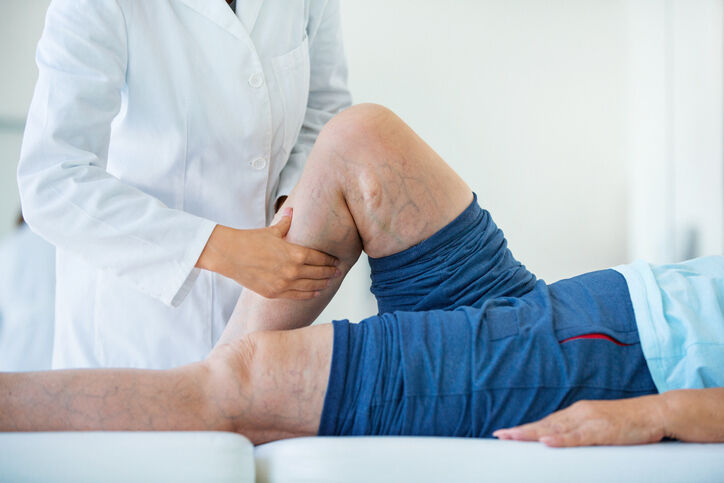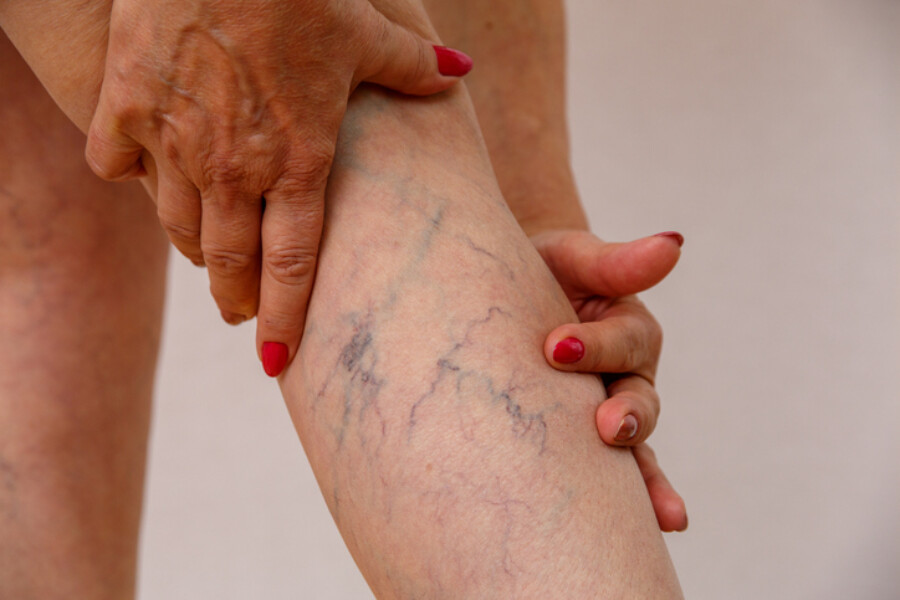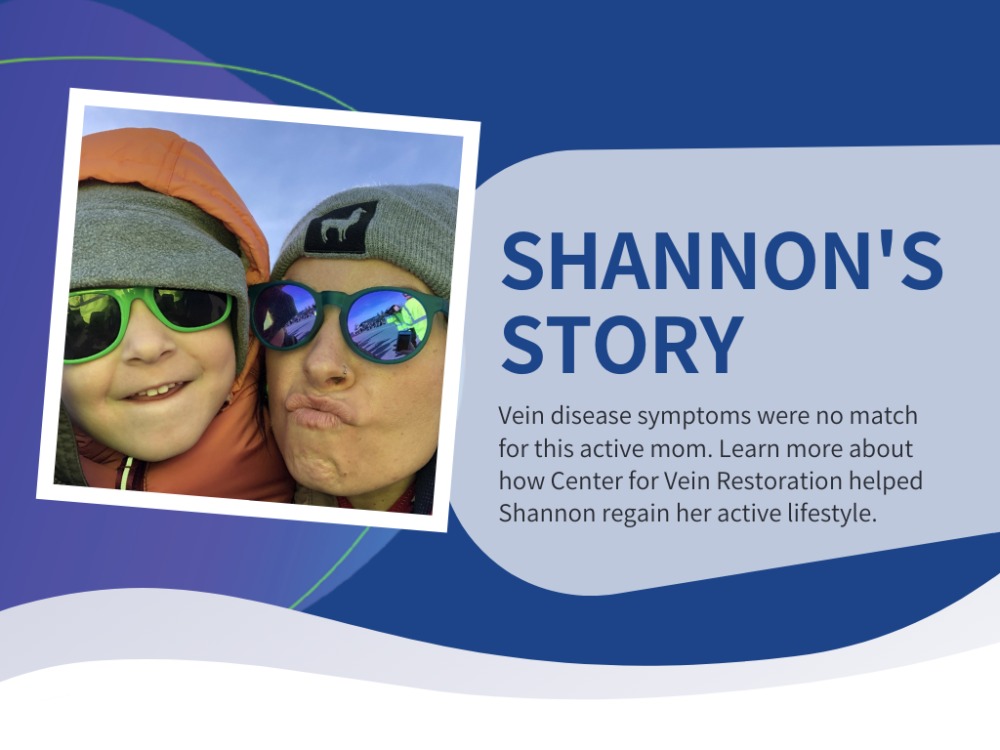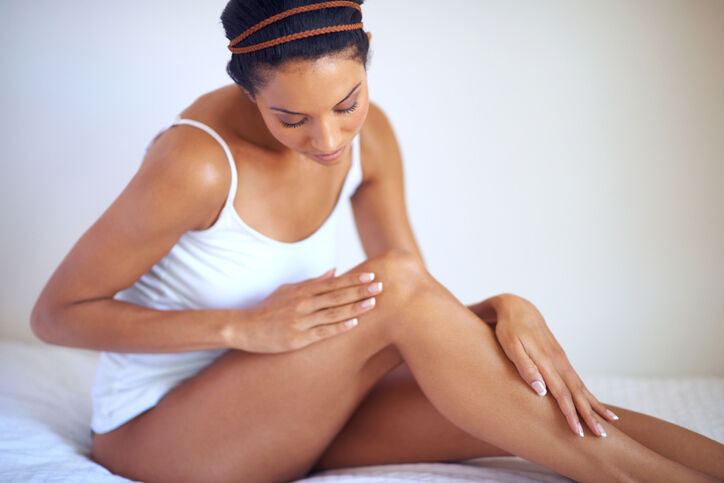Symptoms of varicose veins?
Varicose veins can develop anywhere in the body but most commonly appear on the legs. Visual signs of varicose veins include twisted or bulging veins that look blue or purple but may not always manifest in appearance. Other symptoms to watch out for include:
A heavy, uncomfortable feeling in your legs
Cramping, especially at night
Throbbing or aching in your lower legs
Itching around your veins
Increased pain after long periods of standing or sitting
Swollen feet or ankles
What are the leading causes of varicose veins?
Varicose veins result from weakened or damaged valves within your veins. These valves play an essential role in helping your veins return blood to your heart as it circulates through your body.
For this gravity-defying process to work, muscles in your legs need to contract, pushing the blood upwards. As the blood travels, tiny one-way valves open to let the blood flow to your heart, then close to keep it from flowing backward and pooling in your legs.
However, if these valves malfunction, the blood pools, increasing pressure in the vein and causing it to bulge, stretch or twist in the form of varicose veins.
Over time, this buildup can eventually weaken the walls of the vein, force blood to leak out of the vein and into the surrounding skin. This causes the skin to turn brownish-black, lose its suppleness, and eventually become hardened as a result of scar tissue.
Common risk factors
Varicose veins can also be inherited or triggered by factors such as:
Age: The risk of developing varicose veins increases as you get older. Aging brings natural wear and tear to your valves that can eventually lead to malfunction and blood pooling in your veins.
Sex: Women are more likely than men to develop varicose veins due to the female hormones such as estrogen and progesterone that tend to relax vein walls.
Obesity: Being overweight increases the pressure on your leg veins.
Pregnancy: The increased amount of blood in your body during pregnancy can enlarge the veins in your legs. Fortunately, these varicose veins will usually go away on their own following the pregnancy.
Menopause: Hormonal changes associated with menopause are believed to be a cause of venous disease like varicose veins.
Lifestyle: Spending long periods of time, either sitting or standing, can increase your risk of varicose veins. Your blood can’t flow as well when you’re in a single position for a long time.
Heredity: A family history of varicose veins is likely a factor in a individual’s potential for developing them.
How are varicose veins diagnosed?
While it is often possible to self-diagnose varicose veins based on visual symptoms, a professional diagnosis is necessary for treatment. For that diagnosis, your doctor will begin with a physical examination and a review of your medical history.
An experienced vascular technician will perform a venous ultrasound to determine whether the leg veins are functioning normally and to look for signs of any current or previous blood clots. Blood clots can be life-threatening.
A standard ultrasound won’t be enough to evaluate some veins, because they are challenging to see. In such cases, an MRI, CT scan, or venogram may be necessary to ensure proper diagnosis.
Spider veins and varicose veins: what’s the difference?
Spider veins (Telangiectasia)and varicose veins both stem from similar issues with blood flow. Spider veins are smaller and found closer to the surface of the skin compared to varicose veins. They are often red or blue in color and often look like a web of blood vessels on the skin . While spider veins can occur on the legs just like varicose veins, they also frequently appear on the face.
Although spider and varicose veins have similarities, there are some distinct differences between the two. While varicose veins are swollen and can be quite painful, spider veins don’t typically hurt.
If you’re not sure whether your visible veins are varicose veins or spider veins, it’s important to see a doctor right away. While spider veins are typically more of a cosmetic concern, if left untreated, they can lead to serious complications.
What happens if I leave varicose veins untreated?
Untreated varicose veins can cause more than cosmetic concerns or minor pain. The major risks associated with leaving them untreated fall into three categories:
Bleeding: Given that varicose veins are often inflamed and close to the skin, they are more susceptible to cuts than regular veins. That means people suffering from varicose veins can often bleed extensively from relatively minor injuries.
Venous Ulcers: Difficult to treat, venous ulcers are open sores that result from poor circulation. The most common form are leg ulcer symptoms are extreme pain, significant discoloration of the surrounding skin, inflammation, and a sense of heaviness in the affected limb. Venous ulcers can also generate pus and emit an unpleasant odor.
Blood Clots: The most significant danger of untreated varicose veins is an increased risk of developing blood clots. When blood accumulates from malfunctioning valves, the obstructed circulation can promote clotting. A clot that detaches and becomes lodged in the lung can trigger potentially deadly conditions such as thrombophlebitis or deep vein thrombosis (DVT).
Treating varicose veins
Now that you know the risks of leaving varicose veins untreated, it’s time to understand what treatment entails. Treatment falls under two primary categories: self-care and professional treatments.
Self-care approaches can ease pain and keep your existing varicose veins from worsening. Still, they cannot eliminate your varicose veins. These lifestyle approaches include losing weight, exercising, wearing loose-fitting clothing, elevating your legs, and avoiding long periods of standing or sitting.
Historically, manual ligation (tying off of the vein) and vein stripping (pulling the vein out) where the only options.
Thankfully, newer surgical interventions span across a wide range of options to fit your needs. These procedures require only a brief office visit, minimal local anesthesia, and minimal downtime with today’s technology. The most common varicose vein treatments are:
Varithena: A minimally-invasive, non-surgical procedure, Varithena involves the doctor injecting a small amount of microfoam that irritates and collapses the swollen vein.
Ultrasound-Guided Foam Sclerotherapy: The doctor will use ultrasonography to guide a needle into the affected vein during this process. A solution called a sclerosant is then injected, initiating a reaction that seals the vein shut and reroutes blood to healthier veins.
VenaSeal: Because VenaSeal does not require any heat or sclerosants, it tends to be more comfortable than other varicose vein treatments. The doctor uses a proprietary medical adhesive to close off the affected veins.
ClariVein: ClariVein is a minimally invasive treatment option involving a catheter inserted into the vein to inject a sclerosing agent. ClariVein requires only a single entry point into the vein. A tiny rotating wire tip then destroys the diseased vein.
Laser Ablation: A thin fiber is gently inserted through the skin into the affected vein during laser ablation, or endovenous ablation heating the vein and causing it to close. The closed vein is then reabsorbed into the body, and the blood is naturally rerouted through other, healthier veins.
Radiofrequency Ablation: A catheter is inserted into the vein and emits radio waves that heat and seal the affected vein during radiofrequency ablation.
Ambulatory Phlebectomy: Usually conducted at the same time as laser or radiofrequency ablation, ambulatory phlebectomy involves the doctor extracting the diseased vein via two small incisions made in the skin. These incisions are so small that they rarely require stitches to heal.
To learn more about varicose vein treatments, check out The Complete Guide to Varicose Vein Treatment.
Post-procedure care for varicose veins
No matter which varicose vein treatment you receive, following a few post-procedure care tips is essential to ensure proper healing.
In general, side effects are mild and you can resume your normal activities right away with few restrictions. Just be aware that you may experience some discomfort and bruising along the course of the treated vein. This bruising may be particularly extensive in the thigh, but it should resolve in one to two weeks.
If you want to take something for pain relief, you can try an over-the-counter pain reliever, but make sure you take it with food to avoid irritation.
Although you can begin normal activities almost immediately, follow your health care provider’s advice about strenuous exercise like running, weight lifting, or cycling.
You should also avoid lifting anything over 20 pounds during this time. If you’re interested in getting some exercise, try a modified workout.
Walking post-procedure is highly encouraged. In fact, walking is great for your varicose veins in general, even when you aren’t recovering from a procedure.
Treadmill use is fine, but make sure you aren’t running or engaging in vigorous activity that could exert extra force on the lower extremities, as this could interfere with your healing.
It’s also important to avoid soaking in pools, hot tubs, or even bathtubs for seven to ten days following the procedure. While showering is fine, you should wait at least 24 hours before removing the bandaging around your leg.
Steps you can take to prevent varicose veins
You can make lifestyle changes to help reduce your risk of developing varicose veins or ease the discomfort of varicose veins. These include:
Maintaining a healthy weight
Exercising regularly (even doing something as simple as going for a daily walk can help prevent varicose veins)
Eating a high-fiber, low-salt diet
Elevating your legs when possible to reduce pressure on your veins and valves
Avoiding high heels and tight hosiery
Regularly changing your sitting or standing position
Wear compression stocking
Begin your journey to healthier veins today
Varicose veins are a common condition, but they can carry some significant, even life-threatening, risks in the form of blood clots if left untreated. Varicose veins can be sign of other venous disease, such as Chronic Venous Insufficiency.
If you believe you may have varicose veins, you must see a doctor right away. A vein doctor can diagnose your condition and determine the best plan of action to address your current varicose veins and keep new ones from developing.
At Center for Vein Restoration, our experts help patients find the right varicose vein treatment plan to meet their unique needs. We can guide you throughout the varicose vein diagnosis, treatment process, and beyond. Schedule a consultation with us today!



